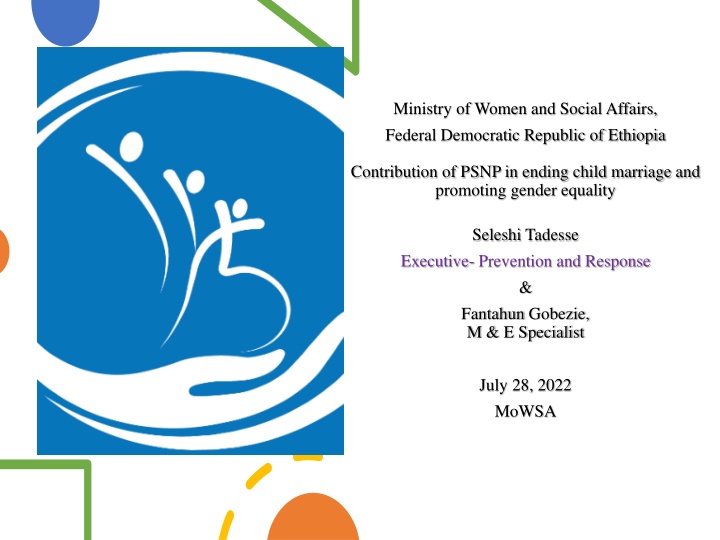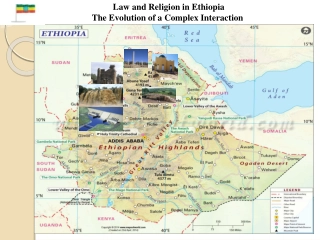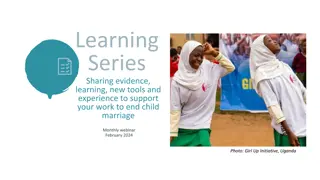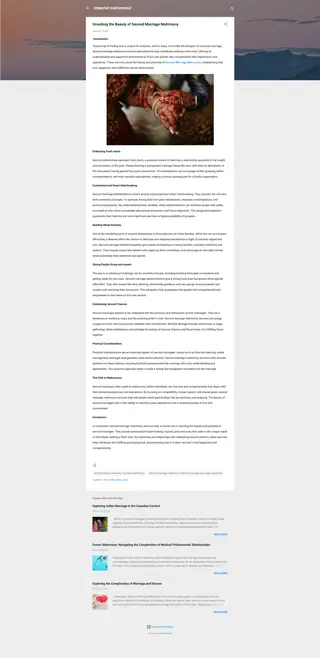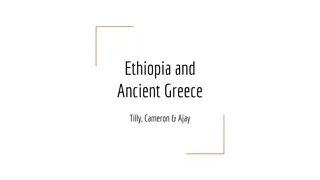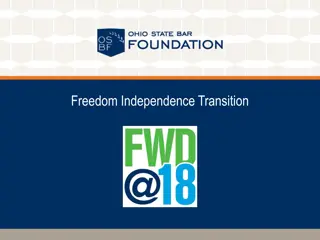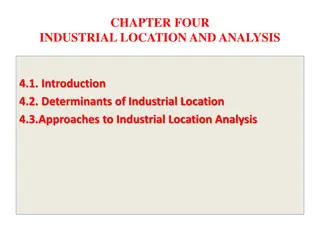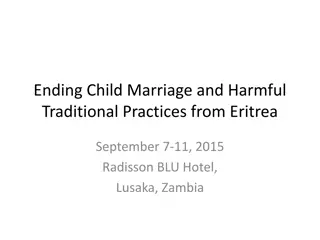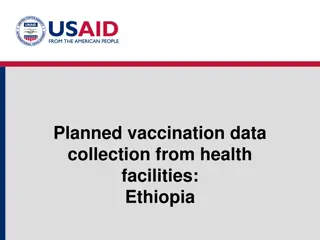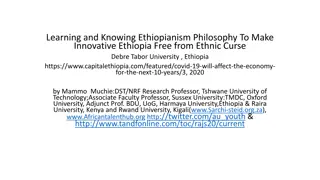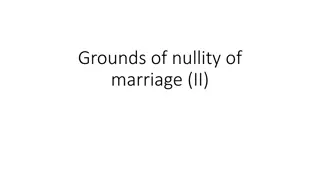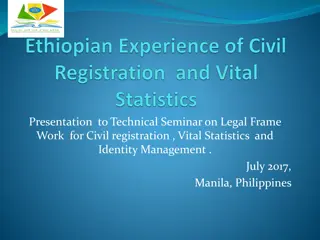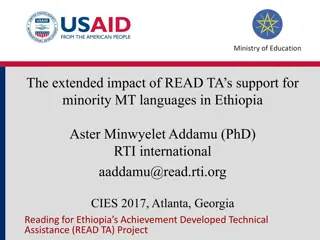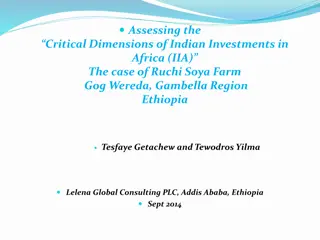Progress in Ending Child Marriage in Ethiopia
The Ministry of Women and Social Affairs in Ethiopia has made significant strides in combatting child marriage through policy, legislation, and initiatives. Recent data shows a decrease in the prevalence of child marriage, with efforts focused on addressing the complex factors like poverty driving this harmful practice. Various strategies, including setting a minimum marriage age of 18 and launching national roadmaps, aim to end child marriage and promote gender equality in the country.
Download Presentation

Please find below an Image/Link to download the presentation.
The content on the website is provided AS IS for your information and personal use only. It may not be sold, licensed, or shared on other websites without obtaining consent from the author.If you encounter any issues during the download, it is possible that the publisher has removed the file from their server.
You are allowed to download the files provided on this website for personal or commercial use, subject to the condition that they are used lawfully. All files are the property of their respective owners.
The content on the website is provided AS IS for your information and personal use only. It may not be sold, licensed, or shared on other websites without obtaining consent from the author.
E N D
Presentation Transcript
Ministry of Women and Social Affairs, Federal Democratic Republic of Ethiopia Contribution of PSNP in ending child marriage and promoting gender equality Seleshi Tadesse Executive- Prevention and Response & Fantahun Gobezie, M & E Specialist July 28, 2022 MoWSA
Situation, Legislations, policies and Initiatives to curb Child Marriage in Ethiopia Seleshi Tadesse Executive- Prevention and Response
According to the recent data from the 2016 Demographic and Health prevalence of child marriage in Ethiopia is decreasing. Survey (DHS), Situation of CM in Ethiopia The percentage of girls married before age 18 decreased from 59 per cent in 2005 to 40 per cent in 2015. The percentage of girls married before age 15 dropped between 2011 and 2016 from eight per cent to six per cent
Several policy and legislative initiatives have been set up to end child marriage in Ethiopia. The Family Code (revised in 2000) sets the minimum age of marriage at 18 years for boys and girls (Art. 7). Legal and Strategic framework Article 648 of the Criminal code of 2005 criminalizes child marriage, The criminal code also criminalizes early forced marriage (Art. 648). On August 14th 2019, MoWCY launched a National Costed Roadmap to End Child Marriage and Female Genital Mutilation/Cutting(2020-2024). The Roadmap is an evidence-based, costed plan which outlines strategies, interventions and expected results towards the elimination of these harmful practices, an additional step forward in the country commitment to achieve the SDGs. In 2012, Ethiopia established the National Alliance to End Child Marriage and FGM
Child marriage is a complex problem, which takes different forms and results from the interplay of social, cultural, religious and economic factors CM and Poverty as drivers Economic hardship and poverty are critical drivers of child marriage in most parts of the country. The relationship between poverty and child marriage is not always straightforward. For the poorest and most vulnerable households, child marriage is key strategy for establishing economic security for the girl or coping mechanism for the family. Child marriage, often driven by poverty and supported by social norms and traditions
Poverty may serve as a pushfactor for child marriage in several ways: Drivers of child marriage in Ethiopia 1) pushing girls out of the household due to scarce resources and inability to provide for them, 2) providing an incentive to marry girls out of the household in order to receive bride price payments, 3) creating an incentive to marry girls earlier as younger girls typically dowries(18), or require the smallest 4) creating an environment with a lack of alternative education or employment opportunities. 5)Sometimes, adolescents themselves may initiate child marriage to escape intense wage labour necessitated by household poverty.
The initiatives identified in the assessment generally consist of the following approaches: Child marriage prevention initiatives 1) empowering girls with information, skills and support networks; 2) educating and mobilizing parents and community members; 3) enhancing the accessibility and quality of formal schooling for girls; 4) offering economics support and incentives for girls and their families; and 5) fostering an enabling legal and policy framework
The policy recognizes also vulnerabilities not only at the household level but also at individual level. Social protection and Gender equality It is also believed that lifting households from poverty means creating favourable environment for the growth and development of adolescents. A very progressive policy that explicitly understood the different living status of women and stated female heads, pregnant women, and women in marriage in the five focus areas of SP in Ethiopia: Promoting productive safety net Promoting and livelihood Promoting social insurance Increasing equitable access to basic social services, and Providing legal protection and support to those vulnerable to abuse and violence. improving employment and
Government strategies on the provision of social protection packages are closely intertwined with gender equality, women empowerment and lifting out them from poverty. Social Protection and Child Marriage Intervention mechanisms such as the government s Food Security Programme and job creation packages in both urban and rural safety net programs attempt to protect and promote livelihoods of vulnerable women in rural and urban areas of Ethiopia. Social environment for promoting the economic empowerment of the poor women protection creates an enabling
While the PSNP in Ethiopia does not have explicit objectives related to prevention of child marriage, Social Protection and Child Marriage It is increasingly argued that social protection programmes, and cash transfers in particular, can delay child marriage. Based on the available evidence of linkages between child marriage and the PSNP, further research is needed to understand better the potential role that PSNP, and complementary interventions can play in delaying child marriage and unpack the channels through which these outcomes emerge.
Key pillars of the Road map strategy Creatingand strengtheningan enabling environment Communityengagement(including faithandtraditionalleaders Empowering adolescentgirls andtheirfamilies Enhancingsystems, accountabilityand servicesacrosssectors Increasing data and evidence generation and use.
PSNP vs. Child Marriage Niches of opportunities to curb child marriage in Ethiopia By Fantahun Gobezie M & E Specialist-PSNP
In PSNP-4, Gender Mainstreaming (as a cross-cutting intervention) included in the Design, but interventions were not as such clearly stipulated and not successful ( refer the PSNP-5 design document lesson part), was boldly PSNP vs. Child Marriage Background- Pre-PSNP-5 Lessons from PSNNP-4 revealed that implementing agencies were not sufficiently responsive and accountable for Gender provisions, More than 900,000 girls can be reached in this program only as about 11.5% of Ethiopian population is estimated to be adolescents girls since the Rural PSNP serves about 8 million people ,
What we learnt from the Cash Plus PSNP Cash transfers positively contributed to delay child marriage as it improves income and empower them to push aside economic factors for child marriage, Importance of access of PSNP clients to social services: Health (linking clients into Community based health insurances, fee waivers, NGOs etc., Education (Prevention of school dropouts, manage cancelation of child marriage, enhance enrollment of children to school and delay child marriage, mobilize local resources for education materials for children of poor families etc.) Child protection (SBCC sessions enhance awareness of communities on child protection, legal age of marriage, other harmful practices against girls etc.), The role of case management in PSNP interventions, Social workers engaged in identifying, reporting and mitigating child marriage cases, So, the important roles of Social workers to play in the program became clearer
PSNP-5 design document clearly incorporates the prevention and mitigation of Gender and HTPs in PSNP-5 intervention regions/woredas across all outputs, Integration of child care centers (as an early childhood development intervention) along with public worksites, PSNP-5 committed one output for Linkages to Available Social Service (LASS) where child marriage is one among others, apart from mainstreaming gender sensitivity approaches in each outputs, What is new in PSNP-5?
LASS output clearly stipulates: Rollout of linkage to social services intends to include child marriage cases into legal [child] protection systems in the PSNP areas, Cont. What is new in PSNP-5 One of the strategies to improve linkages is leveraging PSNP SBCC platforms to boost demand including legal protection to girls against child marriages, Improve justice/legal service seeking behavior of PSNP clients to prevent and mitigate incidences of child marriage and other GBV and, Social workers shall provide psychosocial support counseling comprehensive case management approaches, services through
Social and behavioral change communication (SBCC) stipulates: The legal age of marriage for girls and boys is 18 years and above, Cases of Child Marriage can be brought to the Kebele (the smallest government structure in Ethiopia) Appeal Committee (KAC) who will then involve the local law enforcement officers to take over the case before the law, Enhance Knowledge to be transferred to clients to delay child marriage practices, What is new in PSNP- 5?....
Social communication (SBCC): and behavioral change What is new in PSNP-5? What Knowledge is important to be transferred to clients to delay child marriage practices, Improved through safety net transfers Increased investment in girls education shall payback to the family Improved knowledge of, and attitudes towards child marriage so as to clearly put it is illegal and inhumane etc. economic security
CM Affects reproductive health: Child brides, most likely, give birth to children without having enough nutrients for their bodies themselves, leading their children to be affected with multiple development and growth issues, CM affects employment capabilities: Child brides will not continue their schooling which makes their chances of occupying professional occupations slim to none, CM affects autonomy and empowerment: Child brides are most likely to continue living in conditions where they do not control resources and abuse is prevalent in the household, CM is a criminal act: The right to free and full consent to a marriage is recognized in numerous international conventions and declarations, and has stipulations set in Ethiopian constitution, consent cannot be free and full when one of the parties is not mature enough to make an informed decision about a life partner, as is the case with CM. What key messages prescribed in PSNP-5 SBCC?
Lacks specificity to child marriage as PSNP-5 is relatively sponsored social protection program (addresses about 8 million clients in 485 woredas/districts in Ethiopia) huge state What limitations/drawb acks PSNP in relation to CM? Shortage of skilled social workers (to facilitate conversations/SBCCs, case identification and reporting, systematic data management etc.) community mitigation and Shortage of financial and material resources
Session on Child marriage Illustration of SBCC Job Aid 1.
Session on Child marriage Illustration of SBCC Job Aid 2
Though prevention of child marriage is not an explicit objective of PSNP, periodic monitoring and supervision is conducted with checklists inclusive of gender (proportion of women in each service components, child marriages aborted, other harmful practices like girls circumcision averted etc.), Conclusion The midterm evaluation is going to happen after January 2023 and the evaluation tools shall be inclusive of gender related materials including child marriage related indicators like number of child marriages reported, aborted and legally/traditionally resolved etc.
PSNP clients through proper practice of PSNP provisions can mitigate financial pressures that push them to marry off girls in order to cope better with poverty and income shocks; it also improves parents financial capacity to keep girls in school and to invest in their human capital, through better food and health care, Cont. Conclusion The complementary components of PSNP shift attitudes and perceptions the interaction of PSNP district/community level social workers, and co-responsibilities in education have been found to play an important role in shifting parental and girls attitudes and beliefs around child marriage clients with
